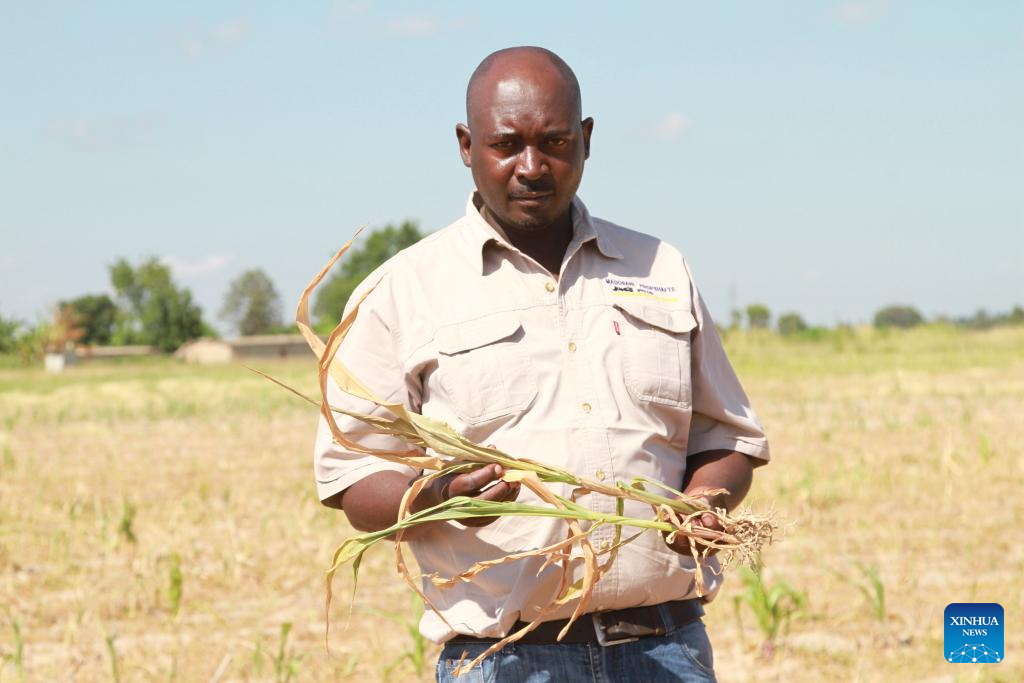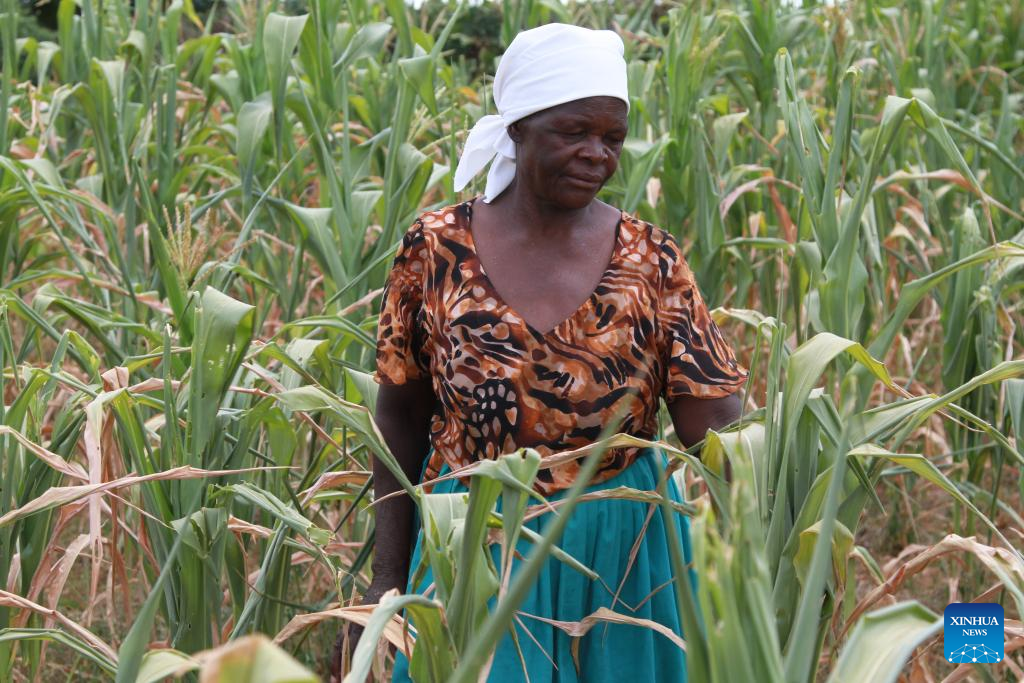
Farmer Farai Mawarire holds a wilting maize plant at his farm in Beatrice, about 40 km to the southwest of Harare, Zimbabwe, on Feb. 26, 2024. (Xinhua/Tafara Mugwara)
BEATRICE, Zimbabwe, Feb. 28 (Xinhua) -- Holding hands behind her back, Jane Chari looked at her wilting maize crop in a parched field in Beatrice, about 40 km to the southwest of Harare, Zimbabwe's capital.
The 64-year-old grandmother's hope for a harvest is now all but evaporated in the arid air.
"It's so painful that I cannot sleep, worrying how I will feed my grandchildren," Chari said.
A dry spell has persisted in Zimbabwe for close to a month, hurting the maize crop, her only source of livelihood.
"I have never seen this level of wilting. I cannot even think of how we are going to survive," Chari said. "We are totally clueless."
Erina Mazwi, another farmer from the same area, said groundwater is drying up, and it is now very difficult to get water from wells.
"I was expecting a bumper harvest, but the dry spell changed all that," she said. "It is just painful. Sometimes I wonder how I am going to feed the family."
Maize, Zimbabwe's main staple crop, does not take droughts kindly. Due to a lack of access to irrigation facilities, small-scale farmers like Chari and Mazwi are at the mercy of the increasingly unpredictable weather.
The meteorological services have warned of below-normal rainfall due to the impact of El Nino, a phenomenon that warms parts of the Pacific, affecting weather patterns.
Zimbabwe's main rainfall season normally runs from October to March, but due to El Nino, it was delayed by about five weeks, subjecting early planted crops to moisture stress.
The situation was further exacerbated by the ongoing dry spell.
The World Food Program (WFP) warned last Tuesday that more people in Zimbabwe will likely require emergency food aid during the lean season when rural households face grain shortages while waiting for the harvest.
The government, in its latest livelihood assessment, said about 2.7 million people in rural areas, out of the country's total population of 16 million, face food insecurity in the current lean season, which typically starts in October and reaches its peak between January and March.
Farai Mawarire, another farmer from Beatrice, said the dry spell caught many farmers unprepared, adding that farmers need to consider drought-resistant crops such as traditional small grains.
"In the previous years, we would harvest with no challenges, so we never considered drought-resistant crops such as millet or sorghum. We have learned a lesson, and in the following seasons we will adopt drought-resistant crops," he told Xinhua.
While Mawarire's maize crop is now a write-off, his fallback is on groundnuts.
"Of all the crops that we cultivated, only groundnuts are promising," he said. "If we receive rains, even once, they will mature. That's our only hope for a harvest."
Meanwhile, Gilbert Mukatyei, another farmer, confronted the drought with climate-smart agricultural practices such as deep plowing, mulching and adopting early maturing crop varieties.
"Besides the deep plowing, we are also applying manure. We are also irrigating, and we are going to increase the number of boreholes this year. We also want to go solar (as a power source for irrigation)," he told Xinhua. "We have plenty of sunshine here. We need to make use of it."
The effects of the drought are being felt in other sectors of Zimbabwe's economy as well.
Tobacco, one of the highest foreign currency earners for the country, has also been affected by the dry spell, and slightly reduced yields are expected.
The tourism sector has not been spared either. At least 100 elephants died in Hwange National Park, Zimbabwe's largest game reserve, due to the drought late last year, according to the International Fund for Animal Welfare.
Finance Minister Mthuli Ncube has projected that Zimbabwe's 2024 economic growth rate will slow to 3.5 percent, down from 5.3 percent in 2023, partly due to the expected impact of El Nino. ■

Farmer Jane Chari looks at her wilting maize crops in a parched field in Beatrice, about 40 km to the southwest of Harare, Zimbabwe, on Feb. 26, 2024. (Xinhua/Tafara Mugwara)



